Determination of further training needs, based on the corporate strategy
1. The necessity of a strategy-oriented analysis of further training needs
The scarcer the means, the greater the inclination to neglect the determination of training needs of employees. The employer knows his employees and must have the last word over all others on training and education without having to consult experts for a lot of money. This all too frequently encountered view is based on the following:
- Further training not based on a strategy and demand-oriented elimination of deficits in knowledge and abilities is a waste of time and money.
- The scarcer funds and time and the more urgent the need to remedy the lack of knowledge and ability, the more necessary it becomes to identify and address the deficits which can stand in the way of success.
It is not useful to single out some weak points and planning and implementing further training measures because “something has to be done for the staff” (training as mainstream trend). Operational further training cannot and may not be done according to the training wishes of the employees. All operational further trainings must be useful to the enterprise. The time and material costs are then justified and acceptable.
However, this is only feasible, if the further training need is determined considering:
- employees
- tasks and activities
- strategies
Then it is guaranteed that the employees will have the required ability, knowledge and skills to adequately cope with the tasks they have to fulfil. Thus corporate strategy forms the starting point and basis for a targeted analysis of training needs.
2. Corporate strategy as starting point
2.1 Factors of strategy development
Strategies are by no means just something for major companies that can afford the luxury, the man-hours, the qualified staff and the costs for this “unproductive” work. A lot of ignorance and errors lie behind this popular opinion. Strategy development is logically one of the routine tasks of the executives or the management. Everybody who is self-employed or responsible for his enterprise should dedicate himself and his enterprise to strategies.
For our task of determining the further training needs on the basis of the corporate strategy, the knowledge of the elements of a strategy and its composition is an essential prerequisite, hence the following comments.
Each strategy consists of three basic factors:
- The initial position: These are the starting conditions of enterprise start-ups, usually the results of the last business year for older enterprises.
- The objective: Includes the various aims, based on the initial position relating to economic conditions, market developments, ambient factors, targets, financial, technical and manpower resources etc.
- Measures for achievement of aims: i.e. the planning of measures to assist in the achievement of aims.
Simply put, the corporate strategy is the definition of the enterprise objectives based on the analysis of the initial position and the planning of measures for the achievement of the aims.
2.2 Analysis of the initial position
Each analysis of the initial position will concentrate on three central issues:
- Have the targets for the ended or ending financial year been reached or not?
- What were the causes for a failure to hit the targets?
- What conclusions can be drawn for the future from the development of own products (by the enterprise), the market, competition, and recognisable (economic-political) development trends?
2.3 The development of enterprise targets
Targets are definitions of results which should be obtained by means of certain measures.
Here three questions have to be asked: (1) What (content of objectives) should be achieved? (2) When, by when, should something be achieved (time frame)? and (3) How much should be achieved (extent of aims)?
A target formulation under consideration of these requirements would therefore read approximately as in the following example: “The turnover (what?) of our organisation, by the end of 2010 (by when?), increase by 10 per cent from 5 mill. € to 5.5 mill. € (how much?).”
The following additional requirements for objectives should also be stressed:
The objectives should be:
- realistic (attainable, not overtaxing, not trivial)
- unequivocal (clear, not liable to misinterpretation)
- measurable/verifiable (quantified or operationalised where possible)
- constant (serving the orientation, therefore unchanging)
- complete (see above - requirements for establishing objectives)
- identifiable (appropriate to the level the objective should address).
The last requirement calls for a breakdown of enterprise objectives. Underlying strategies with further underlying aims are developed to this end; their fulfilment is a prerequisite for the attainment of the enterprise objectives. This means at the same time that no underlying strategy and no underlying aim may contradict the enterprise strategy and its aims (avoidance of conflicts of objectives). Thus an aim hierarchy is built in the enterprise as shown in the following figure.
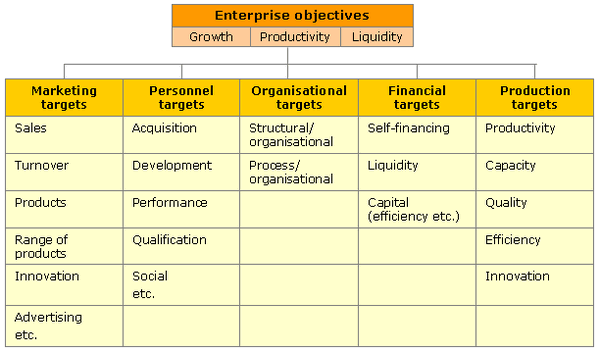
This list is not exhaustive.
In the context of the target control the targets have to be checked, whether they:
- can be financed with the resources of the enterprise or the additionally scheduled funds,
- are attainable with the available means (number, knowledge, skills?),
- conform to the legal and economic limitations,
- do not cause conflicts of objectives (investments, funds, production, employees?)
2.4 Planning of measures
All too often, there is the urge to spontaneously and instinctively take measures required to reach a vague objective ("We can introduce overtime, then we'll cut costs", "I'll buy a new machine, then we'll increase turnover”, "We can train the staff, then we'll increase productivity"). With such procedures the result is very much determined by chance. However, if measures are to attain the objective with the greatest possible assurance of success, then the measures must be deducted from the aims.
Strategic i.e. targeted planning of measures proceeds accordingly as follows:
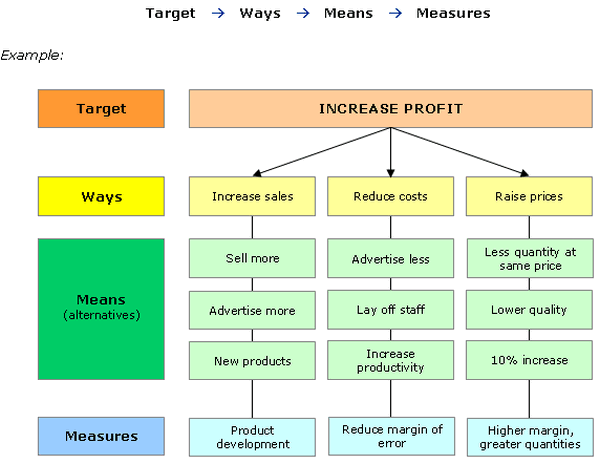
The example assumes that the entrepreneur or the management of the enterprise has decided to increase profits as an objective. There are three ways to achieve the aim (see diagram above): 1. Increase sales 2. Reduce costs and 3. Increase prices. Measures for achieving the aims were development of new products, reduction of margin of error and enlargement of the sales units, together with a simultaneous price rise to increase the profit margin.
After we have become familiar with the elements and the composition of a strategy, the formation of aims and the introduction of measures to achieve the aims, this example should then serve to determine the training needs based on the corporate strategy.
3. The derivation of training needs from strategic objectives
3.1 The methodology of defining further training needs
The methodology of research into further training needs is the target/actual comparison. The future target is the desired state of knowledge, proficiency and ability which must already be there to make a performance and the attainment of a certain result possible. This current target addresses the present existing status of knowledge, proficiency and ability.
From the comparison of current/future targets the following observations can be made:
| Agreement |
= |
No further training needs |
|
or |
|
| Positive deviation |
= |
No further training needs |
|
or |
|
| Negative deviation |
= |
Probable further training needs |
In general, agreement on the further training need is defined as a negative deviation between current and future targets. However, not every negative difference shows an actual further training need (hence the provision "probable" training need). Two factors must be taken into account with regard to this:
(1) The performance motivation
(2) The presence of problem areas independent from employees
(1) Performance motivation
Knowledge and ability are available, but no performance is made. The cause therefore cannot lie in the lack of knowledge or ability, but is possibly due to a motivation problem which cannot be solved by further training.
(2) Problem areas independent from employees
If knowledge and ability are as requested and there is no lack of performance motivation, then other factors must be the cause for the failure to reach the target. Such cases can occur, in the light of experience, due to shortcomings in the management or the organisation of labour (workplace characteristics). These can be addressed on the management level with training measures and on the organisational level with changes in the working conditions. However, other factors can also play a role. For example, political restrictions in health care (cost reductions, health reform bill, health structure bill) have led to considerable losses of turnover and production cutbacks in the pharmaceutical industry. These and other occurrences (natural disasters > hotel and restaurant industry, tourist industry, slump in prices > decrease in domestic demand etc.) do not call for training measures but rather quite another kind of business action. Only the latter can lead to further training needs.
3.2 Definition of future requirements from the strategy
Future targets with regard to further training needs are not defined anywhere in a corporate strategy. They must be developed from the objectives and the measures foreseen to fulfil the targets. This raises a question of crucial importance:
“What do the employees have to know and what abilities must they have in order to carry out the planned measures successfully according to strategy and requirements with the success expected"?
There is no special method for addressing this central issue for the different aspects in the planning of measures. The application of the conditional principle “if – then ...” has however proved itself in practice.
- If the employees are to work without errors, then they must have precise work instructions and professional guidance in the application. As a result, there is a future target: working instruction and teaching.
Applying the conditional principle, we now take a look at our strategy example.
3.2.1 Questioning: planning of measures – innovation
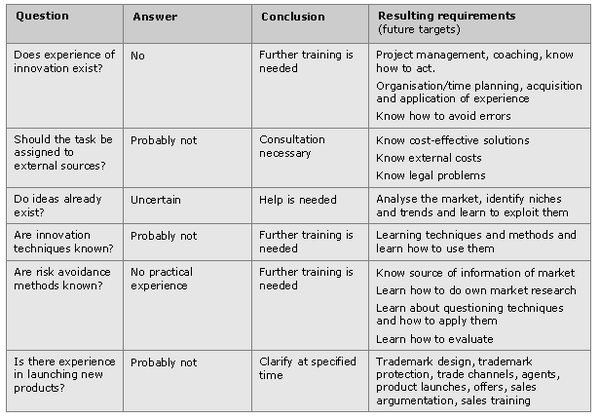
3.2.2 Questioning: planning of measures - reducing error ratio
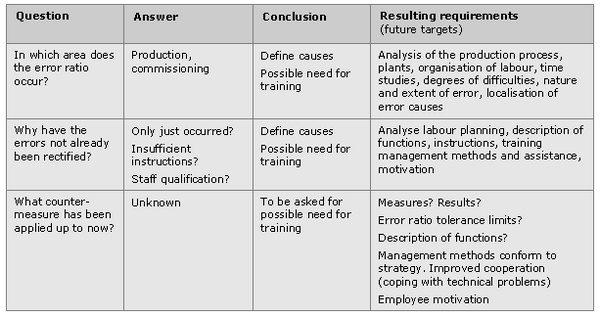
Future targets cannot be formulated without extensive analysis of the product process, operational procedures, labour organisation, management methods and employee motivation. It can generally be assumed that the reduction of error ratios is a logical task of management and staff. The theoretical aim should be zero error. If the reduction of the error ratio is seen – as in this example – as a strategic measure, it can be assumed that more hidden factors are the cause of the difficulties and that they have not yet been recognised by the management. In this regard, the complex causes – present in most such cases – should not be overlooked. Its simple demonstration can clarify research approaches:
3.2.3 Questioning: planning of measures - higher quantities + higher margins
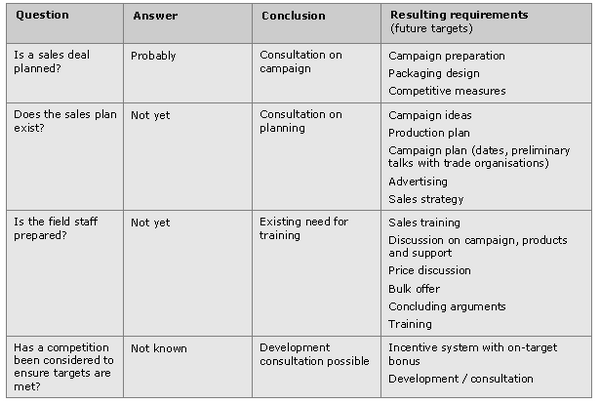
In this planning of targets and measures possible further training needs probably lie only in the area of sales training for employees. Telemarketing should also be examined, if it is relevant for campaign support and if there are further training needs (in-house sales).
3.2.4 Recognising connections
The analyses using the conditional principle only reveal, where further training needs may arise under certain circumstances. The requirements (future targets) found in the tables have therefore only a hypothetical working character. They serve a useful purpose as future target requirements in the definition of further training needs (current/future targets comparisons) and enable short cuts to recognise connections. If we have recognised for example "pressure of time" as a possible factor for causing high error ratios, but also "lack of instruction", "management methods", "performance motivation" and "work planning", we can see interrelations all over.
This allows at the same time the consideration of other factors that have perhaps not been previously recognised i.e.
- Run quantity in production
- Late delivery of production goods
- Overtime etc.
All of which must be considered under current targets.
4. Current target analysis for the definition of learning needs
4.1 Methods for implementing current target analyses
If problems are rather complex, different, self-supplementing methods are applied at the current target analysis. There is no certain that method, but the following methods have been tried and proved:
4.1.1 The exploration
Exploration is a special survey method for researching backgrounds, opinions, experiences and impressions and has proved very useful in addressing learning needs.
It consists of direct interviews with a guide (no questionnaire). In exploration, questions are asked on certain occurrences, events, courses, job performances, knowledge, application difficulties, attitudes etc. By asking a wider perspective is gained.
The special advantage is that the questioner focuses on the answers of the respondent (which is not the case in an interview with a questionnaire). A casual conversation develops in this way, in which the respondent often does not recognize what the questioner is deducing.
In this way, important answers or conceptions are noted literally and later compared with other answers in the analysis of findings.
Disadvantage:
Explorations take a lot of time and should always be conducted in quiet surroundings. The workplace or short work breaks are not suitable for this.
Advantage:
More detailed information, real opinions, views, motivation and attitudes.
4.1.2 The survey
The survey should be implemented as personally as possible with a questionnaire as well. Interviews conducted in writing have the disadvantage that difficult questions are not fully understood, tend to be left unanswered and - as experience shows - a large number of questionnaires is not returned at all.
The nature of the question has great influence on the answers. Therefore, care should be taken with the draft. It is recommended here that trial interviews are conducted in order to ensure that the answers given will really be helpful.
Disadvantage:
The scope of questions must not be too big. Information is therefore limited.
Advantage:
Less time-consuming. Simplifies evaluation by EDP.
4.1.3 The participative observation
Hereby personal participation (not subsequent information) at staff talks, educational measures and work processes is understood. The observer stays completely in the background and does not even interrupt with requests on clarification. He can (but not necessarily has to) make notes and ask questions later. The observer should in any case be present from beginning to end of the proceedings.
Disadvantage:
Time-consuming, in some circumstances intimidates the participants who then tend to hold back.
Advantage:
Direct observations (atmosphere, conflicts, cooperation, sales talk, management conduct).
4.1.4. Further methods:
- Analyses of contents of circulars, project/work plans, training leaflets, work reports, minutes of conferences etc.
- Comparisons with future targets (descriptions of functions, requirement profiles, curricula etc.).
- Examinations, which education and training measures for staff with which success have taken place (What was disseminated? Which is still "a loose end"? What is being applied?)
- Evaluation of performance data/statistics, e.g. production reports, daily reports, activity lists, working days, days absent, delivery plans (dispatch).
4.2 Selection of employees to be interviewed
The selection of the employees to be interviewed in the enterprise is of considerable importance. Interviewing all the employees in an enterprise is usually out of question for time and cost reasons. Only a random sample selection is therefore considered practical. Then it is a question of the size of the sample and the selection criteria. A procedure such as in market and opinion research, which takes a statistical sample with a margin of error (5%+/- or similar), would make little sense. Selection procedures taking every 3rd or 5th employee or using the alphabet are also of little use.
The following methods have been proved as relevant:
1. Form groups with joint tasks and work contents,
I.e. bricklayers, carpenters or plumbers, but not all workers from building trades. This method ensures that job specifications do not overlap. Moreover, it is then easier to identify possible task and group-specific problems and to recognize distinctions between the groups.
2. Record average performances
It is inadvisable to pick out only the reputed "bad apples", nor only "the best ones”. This would lead to false conclusions, which can adversely affect all training measures.
3. Age groups
If further group structuring is still relevant, selection according to age group is useful, e.g. "under 35”, "35 to 45" and "over 45".
4. Staff membership in a company
In view of the fact that certain behaviour patterns can stiffen and become routine over the years, energy and commitment can decrease the duration of staff membership in a company plays a major role. Thus it should be used as an additional criteria.
Not the least important is the consideration of feedback from the management and other executives (supervisors, technical specialists, head of department etc.), even if there are no apparent direct management problems. Since it is already well known that the manner of management has considerable influence on performance motivation, willingness, understanding of tasks and abilities, management and supervision should always be included in any action addressing further training needs.
|
